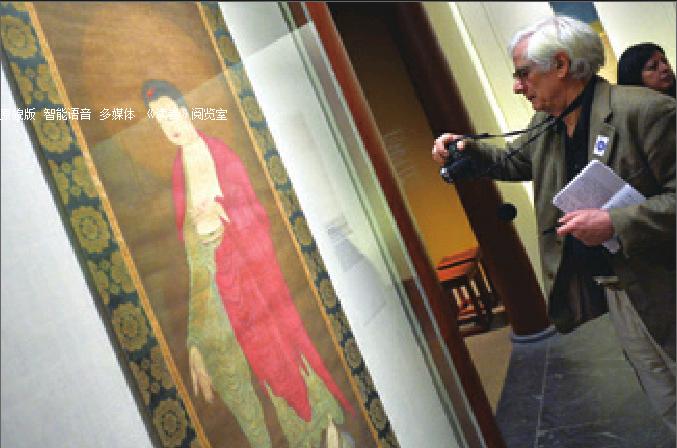Heritage on Display
2015-12-14ByDingYing
By+Ding+Ying


‘Looking closely at the calligraphy, you can feel what the calligrapher felt when he was creating this work,” said Joseph Scheier-Dolberg, Assistant Curator of the Department of Asian Art at New Yorks Metropolitan Museum of Art, as he pointed to one example of calligraphy in an exhibition devoted to Chinese art.
As part of the celebrations marking the 100th anniversary of the Department of Asian Art, the museum, known colloquially as the Met, presented a special exhibition of its best Chinese calligraphy and paintings on October 31. The exhibition features the timeless charm of Chinas ink art and will run through October 11, 2016.
Best of the collection
The museum has selected 110 of the best works from its collection of Chinese paintings and calligraphy. The works embody the historical sweep of Chinas brush arts from the Tang Dynasty (618-907) to the present.
“It took us 100 years to get prepared for this exhibition,” Scheier-Dolberg told Beijing Review at the exhibition preview on October 30. “These works are not only art, but also history.”
The Mets collection of Chinese paintings and calligraphy has grown during the past 40 years to become in Scheier-Dolbergs words“one of the greatest and most comprehensive in the world.”
The exhibition will be presented in two rotations to highlight the finest works of the permanent collection. The first rotation will run through mid-April 2016; the second will start on May 7, and run through the end of the exhibition.
“We have made thorough arrangements to guarantee each of the two rotations present different, unique and irreplaceable masterpieces from our collection,” Scheier-Dolberg said.
One of the exhibitions highlights is the oldest and most storied piece in the Mets collection of Chinese art—Han Gans NightShining White, an 8th-century painting of the favorite horse of Emperor Xuanzong (reign 712-756) of the Tang Dynasty. The paper handscroll features not only the best painting of Han, who was renowned for his outstanding skill of portraying horses, but also a condensed history of Chinese art appreciation.
The original 30.8 x 34 cm painting has been extended to incorporate seals and inscriptions, dating from the 8th century. The seals and comments of emperors, top-level officials, scholars and art collectors document more than 1,200 years of provenance.
Two masterpieces on show at this exhibition represent the pinnacle of Chinese painting in the Song Dynasty (960-1279), according to Scheier-Dolberg. The first is the calligraphy scroll of Biographies of Lian Po and Lin Xiangru by Huang Tingjian (1045-1105), a famous calligrapher, poet, official and scholar of his time. It is one of only three existing long calligraphy scrolls of Huangs cursive writing, and one of the most important examples from the Song Dynasty.

“We can see that Huang was totally immersed in his work when creating this masterpiece,” said Scheier-Dolberg. “The ink was almost dry in the middle part of the calligraphy, but Huang would rather continue because he didnt want to lose the mood and atmosphere.”Scheier-Dolberg explained that the masterpiece fully illustrates Huangs approach to calligraphy. The traces of ink show where Huang wrote quickly and where he slowed down.
“Huang was a master of calligraphy,”Scheier-Dolberg said. “People in New York are fortunate to see this wonderful masterpiece. To see another long calligraphy scroll by Huang, I flew to Beijing last week and waited in line for seven hours in the Forbidden City.”
The second masterpiece is Grooms and Horses by Zhao Mengfu (1254-1322) and dates from the Yuan Dynasty (1271-1368). Zhao was a descendant of the Song Dynastys imperial family.
Grooms and Horses has an interesting story attached to it. In the beginning, Zhao painted his famous work and gave it to a friend as a gift. Decades later, Zhaos son found the painting and created a similar one to the original. A few decades later, Zhaos grandson also made a similar painting to the original. The three paintings were mounted on a long scroll to show the familys history of painting and the different painting techniques of the three generations.
Charm of Chinese art
Scheier-Dolberg said the selected masterpieces clearly illustrate the characters of Chinese paintings and calligraphy in different dynasties. For instance, artworks from the Southern Song Dynasty (1127-1279) are delicate, while those from the Yuan Dynasty are much more unconstrained.
Literati paintings and court paintings also show different styles. The former focus on creating a plain but elegant atmosphere and use light colors, even pure ink, applied with simple strokes. The latter, in contrast, display the palatial, brightcolored and elaborate style of the imperial court.
Chen Wenjuan, a Chinese native woman who has lived in New York City for the past 30 years, said, “This exhibition is a precious opportunity. I am a regular visitor to the Met because I like Chinese paintings, but I have never seen so many masterpieces displayed together before.”
Many Chinese living in New York City took their children to the exhibition. “Maybe my family will remain in the United States forever, but our younger generations should never forget what Chinese art is,” said Li Yuling, the mother of a 5-year-old boy. “I brought my son here to show him why we should feel proud of our culture.”
Several groups of students from the citys high schools were among the visitors, taking advantage of a number of education programs offered by the Met. The Chinese art made an instant impression. “Wow, these are so cool!” one student exclaimed.
“Westerners can experience the beauty of Chinese art too,” said Scheier-Dolberg, “Maybe they cannot understand the exact meaning of the calligraphy and paintings, but they can definitely be attracted by the charm of the art.”
